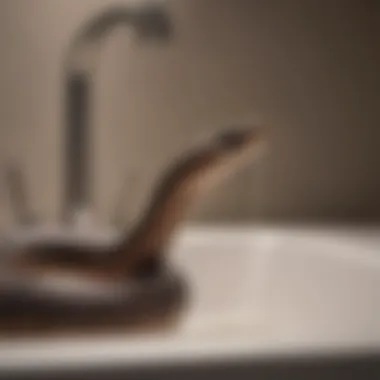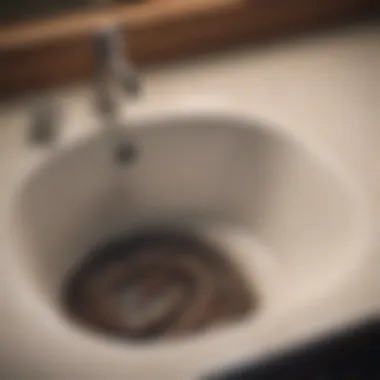Utilizing a Snake for Unclogging Sinks: An In-Depth Analysis


Intro
In addressing the common yet often vexing issue of sink clogs, many homeowners find themselves at a loss for solutions. While various methods exist, the use of a plumbing snake stands out for its effectiveness. This article delves into the mechanics of sink clogs and the specific role of the plumbing snake in resolving these problems. By exploring procedural steps, alternative unclogging techniques, and preventive measures, we aim to equip readers with a thorough understanding of how to tackle this household nuisance.
A clogged sink can disrupt daily routines, whether it occurs in a kitchen or bathroom setting. Understanding the nature of clogs allows homeowners to assess the severity and choose the appropriate response. Notably, plumbing snakes offer a hands-on approach for those who prefer to address these issues independently.
Having the right tools at hand can make all the difference. This article will discuss various unclogging tools, emphasizing the plumbing snake's unique capability to reach blockages that are otherwise inaccessible. As we progress, you will also learn about troubleshooting common pitfalls encountered during the unclogging process, ensuring a smoother experience. Beyond resolution, we will highlight strategies to prevent future clogs, safeguarding your plumbing system.
The following sections aim to provide a detailed yet accessible guide to using the plumbing snake effectively. The comprehensive nature of this article serves not only to educate but also to empower readers to take control of their home maintenance.
Prelude to Sink Clogs
Unclogging sinks is a common household issue that many people face. Understanding sink clogs is essential for homeowners and renters alike. Knowledge about clogs can save time and avoid costly plumbing services. When you know the mechanisms behind clogs, you can take steps to address them effectively. This article will discuss these elements and the benefits of using plumbing snakes.
Understanding the Mechanism of Sink Clogs
A sink clog occurs when water is unable to drain due to a blockage in the plumbing system. This blockage can involve hair, grease, food particles, or other debris that accumulates over time. Water will back up into the sink, leading to inconvenience and potential damage to the plumbing.
Clogs are often more than just a simple obstruction. They can develop gradually, causing slow drainage before resulting in a full blockage. Some clogs form deeper in the plumbing system, making them harder to resolve without proper tools. Recognizing how clogs develop provides insight into prevention and remediation.
Common Causes of Sink Clogs
Several factors contribute to sink clogs. Understanding these common causes can help in preventing future issues. Here are some key causes:
- Hair: Hair is a primary contributor to clogs in bathroom sinks and showers. When hair mixes with soap residue, it can form a dense mass that impedes water flow.
- Grease: In kitchen sinks, grease and fat from food waste can solidify in the pipes, creating a stubborn blockage.
- Food Particles: Small food particles can accumulate over time, especially in kitchen sinks without proper disposal methods.
- Mineral Buildup: Hard water can cause mineral deposits to form. This buildup narrows the pipes and restricts drainage.
- Foreign Objects: Items accidentally dropped into the sink can cause immediate clogs, requiring prompt attention.
Awareness of these factors is crucial for maintaining clear plumbing and avoiding the need for frequent unclogging. Building good habits can lead to easier sink maintenance in the long run.
What is a Plumbing Snake?
In the discussion of addressing sink clogs, understanding what a plumbing snake is holds significant importance. A plumbing snake, often referred to as a drain snake or auger, is a vital tool in the arsenal of any homeowner or plumber. This device is specifically designed to clear obstructions within pipes. Having knowledge of plumbing snakes not only enhances one's ability to manage clogs but also minimizes the need for professional help in minor cases.
The plumbing snake operates on a straightforward principle. It employs a flexible metal cable that can navigate through pipes, reaching areas that are otherwise inaccessible. By turning the handle, the cable spins, allowing it to break through or grab the debris blocking the drain. Recognizing this functionality allows individuals to approach their sink issues with enhanced confidence and understanding.
Different Types of Plumbing Snakes
Plumbing snakes come in various types, each tailored for specific situations. Understanding these distinctions can lead to better choices when facing clogs. The common types include:


- Handheld Snakes: Ideal for less severe blockages, these are usually simple to operate. They are often used for bathroom or kitchen sinks and can quickly free smaller issues.
- Motorized Snakes: For more difficult clogs, motorized versions provide greater power. They are equipped with a motor that drives the cable, making them effective for tougher drainage problems.
- Toilet Snakes: Specifically designed for toilets, these snakes have a distinctive shape that allows them to fit easily into the toilet bowl. They help in clearing clogs within toilet passages.
- Hydraulic Snakes: These use high-pressure water jets to dislodge blockages. They are suitable for larger pipelines and commercial applications, where significant buildup may occur.
Each type has unique advantages, and their effectiveness may vary based on the specific clogging issue. Therefore, selecting the right plumbing snake is crucial to mitigate sink congestion efficiently.
Materials Used in Plumbing Snakes
The materials making up plumbing snakes play a critical role in their performance and longevity. Common materials include:
- Steel Cable: Most plumbing snakes use a high-quality steel cable. Steel provides the necessary strength and flexibility, allowing the snake to navigate bends in pipes without breaking.
- Plastic: Some handheld snakes may feature a plastic design. These are typically more affordable and lighter but may not have the durability of metal alternatives. They are, however, adept at handling minor clogs without damaging the pipes.
- Rubber or Foam tips: Some snakes come with rubber or foam tips that protect pipes from scratches during the unclogging process. This consideration is essential for maintaining the integrity of older or fragile plumbing systems.
Different materials contribute differently to the tool's functionality, highlighting significant factors in their effectiveness and applicability. When selecting a plumbing snake, one should consider these materials to enhance the likelihood of successful clog removal.
The Mechanics of Using a Plumbing Snake
Understanding the mechanics of using a plumbing snake is crucial for effectively addressing sink clogs. This section highlights the approaches and methods for utilizing this device, showcasing its benefits while also considering the relevant factors for success.
A plumbing snake, also known as a drain snake or auger, is designed to navigate through pipes and dislodge blockages. Its significance lies in its capability to reach areas within pipes that are otherwise inaccessible. This tool is a straightforward solution when facing stubborn clogs, often reducing the need for expensive plumbing services.
Using a plumbing snake involves specific techniques that enhance its effectiveness. When executed properly, it can clear most clogs without causing harm to the plumbing system. Understanding these methods allows for a better grasp of when and how to apply them effectively.
Step-by-Step Guide to Using a Snake
- Gather Your Tools: Before getting started, you need to have a plumbing snake, gloves, and a bucket. The bucket will catch any water or debris that may spill when you open the drain.
- Remove the Drain Cover: Use a screwdriver or your hands to take off the cover, providing access to the drain.
- Insert the Plumbing Snake: Carefully place the snake into the drain. Push it gently until you feel resistance. This is usually the clog.
- Rotate the Snake: Once you meet resistance, turn the handle of the snake clockwise. This action helps break apart the clog. If needed, push it deeper to reach the blockage.
- Retrieve the Snake: Pull the snake out slowly, bringing up any debris that was caught. You may want to do this several times to ensure the clog is fully removed.
- Flush the Drain: After using the snake, run water through the drain to test if it is cleared. If the water drains smoothly, the job is complete.
This guide provides clear instructions to successfully use a plumbing snake, encouraging a methodical approach in unclogging sinks. Practicing these steps is crucial for anyone looking to effectively handle common drainage problems.
Safety Precautions When Using a Snake
Using a plumbing snake requires certain safety measures to prevent accidents and injury:
- Wear Protective Gear: Always wear gloves to protect your hands from sharp objects that may be in the drain. Safety glasses can also guard against any potential splashes.
- Avoid Excessive Force: When using the snake, do not apply too much force. This can damage your pipes.
- Secure Loosely Fitting Items: Ensure that your working space is clear of tools and that nothing can fall into the sink during your work.
- Follow Manufacturer Instructions: Every plumbing snake may have different user guidelines. Adhering to these will help ensure safety and efficiency.
Taking these precautions is essential to ensure a safe unclogging process. Always prioritize safety when working with plumbing tools.
Incorporating these precautions will enhance the experience of using a plumbing snake. Being aware of both its mechanics and the underlying safety elements will ensure a more effective unclogging process while minimizing risks.
Effectiveness of a Plumbing Snake
Understanding the effectiveness of a plumbing snake is crucial for anyone who deals with sink clogs. It addresses issues that often frustrate homeowners and renters alike. The plumbing snake, also known as a drain auger, is designed to remove obstructions from pipes, helping restore the flow of water. Its mechanics allow it to maneuver through bends and turns in plumbing, reaching blockages that other tools cannot. This section dives into its advantages and disadvantages in comparison with other methods.


Comparative Analysis with Other Methods
When it comes to unclogging sinks, several methods exist, each with its strengths and weaknesses. Here is a comparison of plumbing snakes against other popular approaches:
- Chemical Drain Cleaners: While these products can dissolve certain blockages, they often contain harsh chemicals that can damage pipes and harm the environment. They may work quickly, but they do not address the root cause of clogs.
- Plunger: A plunger is effective for minor clogs. However, it may not reach deeper blockages located further down the plumbing system. In contrast, a plumbing snake provides a more thorough solution.
- Hydro Jetting: This method uses high-pressure water jets to clear debris. While highly effective, it can be costly and requires professional expertise. Plumbing snakes offer a more affordable option for homeowners.
In summary, plumbing snakes have an edge in terms of versatility and safety when compared to chemical solutions. They also serve as a competent tool alongside plungers and hydro jetting.
Limitations of Using a Snake
While plumbing snakes are effective, they do have limitations. Understanding these can help users set realistic expectations.
- Skill Level Required: Operating a plumbing snake may require a certain level of skill. For those not familiar with plumbing tools, there may be a learning curve involved.
- Physical Strength: Some snakes can be heavy or require significant force to operate, especially in tougher clogs. This aspect might be a barrier for some users.
- Not Suitable for All Clogs: In cases where the clog is caused by tree roots or significant pipe damage, a plumbing snake may be ineffective. This limits their use to specific blockage types rather than all scenarios.
Understanding the limitations of a plumbing snake ensures users are prepared for what it can and cannot do. Proper tools are essential for specific problems.
Troubleshooting Common Issues with Plumbing Snakes
When using a plumbing snake, encountering problems is not uncommon. Thus, addressing these issues is essential for effective unclogging. Troubleshooting allows individuals to identify the cause of the malfunction and apply the right solution. A proper understanding of common problems can save time, reduce frustration, and avoid further damage to plumbing systems.
Dealing with Difficult Clogs
Some clogs can be more stubborn than others. Various factors make a clog difficult to remove. Thick grease buildups, tree roots, or even foreign objects can create strong blockages. In such cases, patience and technique become vital. Here are some methods to consider:
- Increase Pressure: If the snake does not seem to be working, try pushing down with more force or using a different angle. The added pressure can sometimes break through tough spots.
- Alternate Tools: Sometimes, combining tools works best. Using a plunger before the snake can loosen a clog, making it easier to tackle with the snake.
- Check the Snake's Position: Ensure the snake reaches the clog. If it’s too far behind the clog, repositioning or extending the snake might help.
- Use Water: Running hot water while using the snake can help dissolve grease or soap clogs, making it easier for the snake to pass through.
If these steps do not yield results, it may indicate a more serious blockage or problem, suggesting that more advanced techniques or tools might be required.
When to Call a Professional
There are situations when it’s best to seek professional help. Knowing when to call a plumber can be crucial. Here are key signs that you should consider:
- Persistent Clogs: If clogs continue to occur despite repeated attempts with your plumbing snake, this could signal an underlying issue that needs expert evaluation.
- Multiple Fixtures Affected: If multiple sinks or drains are experiencing clogs simultaneously, there may be roots or significant blockages within the main sewer line.
- Severe Backups: If waste or water is backing up into other fixtures, this could indicate a major problem that a professional is better equipped to handle.
- Unusual Sounds or Smells: Strange noises from pipes or foul odors often suggest plumbing issues beyond basic clogs.
Recognizing the right moment to enlist professional services can ultimately prevent larger repairs and costs in the future. Don't hesitate to reach out for assistance when in doubt.
Preventive Strategies for Sink Clogs


Preventive measures play a vital role in maintaining sink functionality and avoiding the inconvenience of clogs. Implementing effective strategies can significantly reduce the frequency of clogs and prolong the lifespan of plumbing fixtures. Addressing this topic is essential, as preventive strategies not only save time but also prevent costly repairs. Prevention is often more efficient than dealing with issues post-factum. By understanding the elements involved in successful prevention, homeowners can maintain a smoother plumbing system.
Regular Maintenance Practices
Regular maintenance is key to avoiding sink clogs. Keeping a consistent maintenance schedule helps catch potential issues early and reduces the likelihood of severe problems. Here are some practices to consider:
- Clear the Drains Regularly: Performing regular checks of the sink’s drainage system can identify blockages before they escalate.
- Use Hot Water: Pouring hot water down the drain on a weekly basis can dissolve grease buildup that typically leads to clogs.
- Check for Leaks: Inspecting plumbing for leaks on a routine basis helps catch issues early, preventing the accumulation of debris.
- Clean the Trap: Removing and cleaning the trap underneath the sink periodically can eliminate trapped materials which otherwise contribute to clogs.
These practices not only maintain the functionality of sinks but also ensure a clean plumbing system.
Best Practices for Sink Use
The way sinks are used can greatly influence the likelihood of clog formation. Adopting certain practices not only safeguards against clogs but also optimizes sink performance. Here are some recommended strategies:
- Avoid Disposing of Food Waste: Even if the sink has a garbage disposal, minimize what goes down the drain. Foods like fibrous vegetables or grains can cause blockages.
- Use a Drain Strainer: Installing a strainer can catch debris that might otherwise slip down the drain, protecting the pipes.
- Mind the Soap: Some soaps can build up in pipes over time. Consider using milder soaps, especially those that are biodegradable.
- Be Cautious with Oils and Fats: Do not pour grease or oils down the sink, as they can solidify and trap other debris.
Incorporating these best practices into daily routines ensures better sink health and prevents future plumbing problems.
Applying preventive strategies is a proactive approach that can safeguard your plumbing system, saving both time and money in the long run.
Environmental Considerations
The conversation surrounding plumbing snakes and sink unclogging often neglects a critical aspect: the environmental impact. This is an essential topic because plumbing practices can significantly affect our ecosystems and public health. Minimizing environmental damage while ensuring proper function within our plumbing systems is key. Therefore, focusing on eco-friendly methods for preventing clogs and understanding the implications of chemical drain cleaners is vital. By exploring these elements, we can align our plumbing solutions with sustainable practices and protect our surroundings.
Eco-friendly Alternatives for Clog Prevention
There are several methods to prevent sink clogs without resorting to harsh chemicals. These alternatives not only help maintain clean pipes but also protect our environment. Some effective eco-friendly strategies include:
- Regular Maintenance: Engaging in routine checks and cleanings can greatly reduce the need for clog removal. This can involve simply flushing your drains with hot water regularly, which helps dissolve grease and soap residues.
- Baking Soda and Vinegar: A natural combination that can effectively deodorize and clear minor clogs. Pour half a cup of baking soda followed by half a cup of vinegar into the drain. Allow it to sit for about 30 minutes before rinsing with hot water.
- Salt and Boiling Water: Mixing salt with boiling water can be a powerful agent against minor buildups. The salt works to break down grime while the boiling water flushes it away.
- Drain Screens: Using screens or traps in sinks prevents hair, food particles, and other debris from entering the plumbing. This simple tool can vastly reduce the occurrence of clogs.
Employing these eco-friendly alternatives assists in maintaining proper plumbing without introducing harmful chemicals into the environment.
Impact of Chemical Drain Cleaners
Chemical drain cleaners are commonly used for unclogging sinks but carry severe environmental implications. These products often contain toxic substances, which can pose dangers not only to plumbing systems but also to human health and ecosystems. Here are some points to consider:
- Toxicity: Many drain cleaners include corrosive chemicals that can damage your pipes over time, leading to more expensive repairs and potentially resulting in further clogs.
- Impact on Water Systems: When these chemicals wash away, they can enter local water supplies, affecting fish and plant life, and even disrupting entire ecosystems. This contamination can have long-lasting ramifications for both wildlife and humans.
- Health Risks: Exposure to chemical cleaners can result in skin irritation, respiratory problems, and other health issues. Proper handling and storage is essential, but even with precautions, accidents can occur.
- Better Alternatives Available: There are numerous environmentally friendly products available today. Investing in these alternatives can prevent harm while maintaining plumbing efficiency.
Epilogue
In wrapping up the discussion, it is imperative to reflect on the significance of employing a plumbing snake for addressing sink clogs. The plumbing snake stands out as an essential tool in the maintenance toolkit of any homeowner or property manager. Its utility lies not merely in its ability to clear obstructions but also in the broader context of maintaining a functional plumbing system.
Summarizing the Utility of a Plumbing Snake
The plumbing snake provides a practical and effective solution for tackling stubborn sink clogs. Its design allows it to navigate through pipes, reaching deep into the plumbing system where other methods, like plungers and chemicals, might fail. When used correctly, a plumbing snake can save considerable time and often financial resources that would otherwise be spent on professional services. Its flexibility is noteworthy, as different types of snakes can be employed for varying degrees of blockage, making it a versatile choice. Whether addressing hair buildup in a bathroom sink or grease accumulation in a kitchen drain, a plumbing snake typically demonstrates effective performance overall.
Final Thoughts on Sink Maintenance
Effective sink maintenance extends beyond immediate unclogging methods. Regular preventive actions can significantly reduce the likelihood of future blockages. Simple practices, such as using drain screens, conscious disposal of food and other waste, and periodic deep cleaning, contribute to a healthier plumbing system. These habits reduce the need for reliance on a plumbing snake or, for that matter, any drastic remedial measures.















